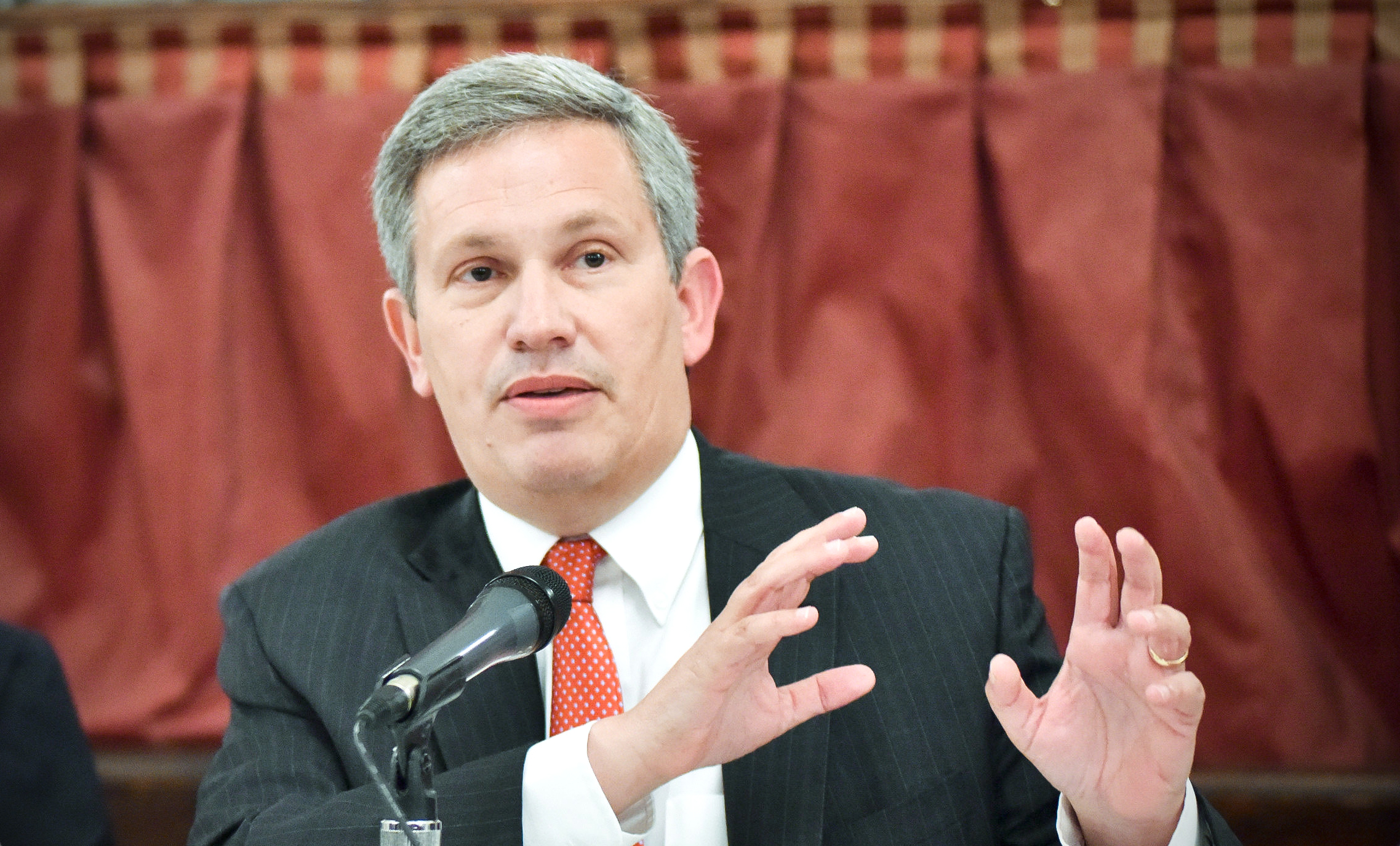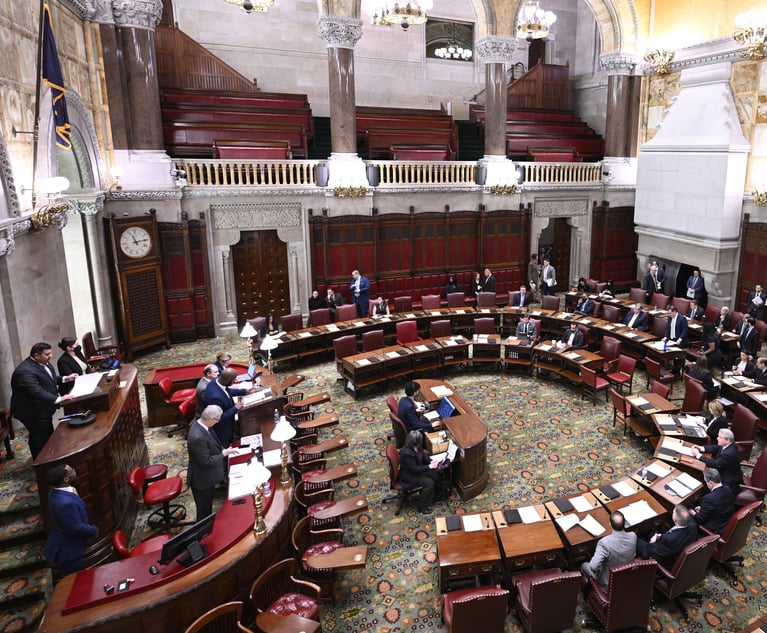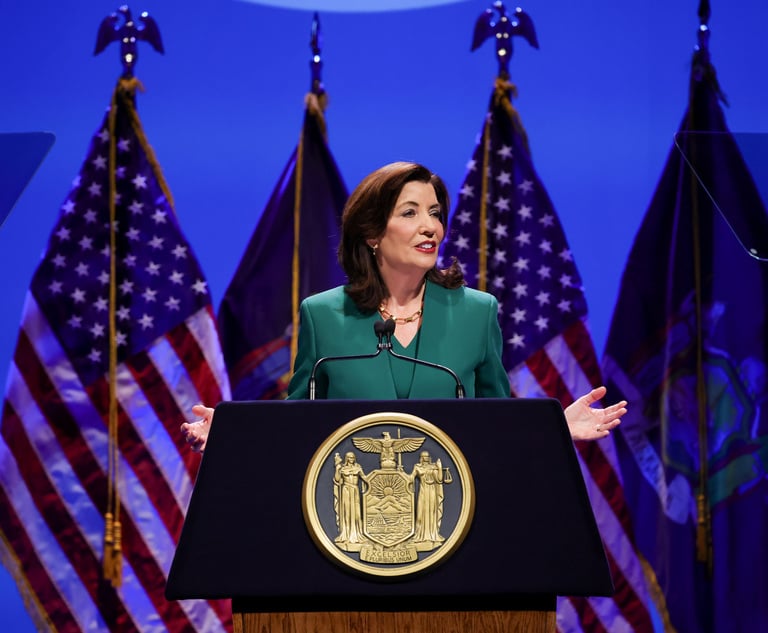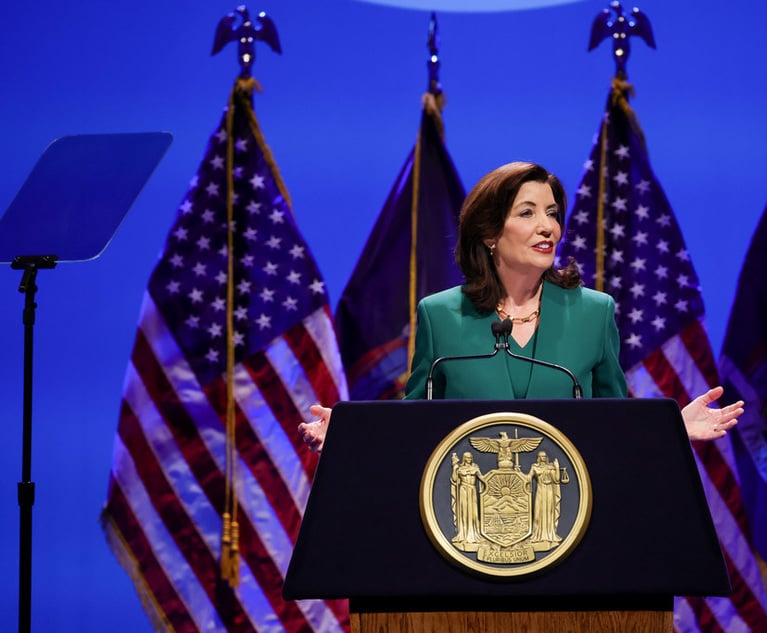Hank Greenberg, NY State Bar President, Aims to Seize Chance to Achieve Long-Sought Legislative Goal
Consolidating the state’s trial courts system and simplifying current power of attorney forms are two measures that could be advanced when lawmakers return to session.
August 15, 2019 at 02:07 PM
7 minute read
 Henry M. Greenberg, president of the New York State Bar Association. Photo: David Handschuh/NYLJ
Henry M. Greenberg, president of the New York State Bar Association. Photo: David Handschuh/NYLJ
Editor’s note: This article is the first in a series.
In the upcoming year, the New York State Bar Association could finally secure two of its long-standing legislative priorities, said Hank Greenberg, the organization’s current president: consolidating the state’s trial courts system and simplifying current power of attorney papers.
Greenberg, a shareholder at Greenberg Traurig, expects the state bar to make headway on both initiatives with state lawmakers next year after accomplishing many of the group’s other priorities in recent months.
Chief among them was defeating an increase to the two-year attorney registration fee, which was proposed in January by Gov. Andrew Cuomo as part of his executive state budget. The plan would have upped that charge from $375 every two years to $425.
The additional revenue would have been earmarked to fund legal representation for low-income defendants. Greenberg said the Bar Association unquestionably supports additional funding for that purpose, but that it shouldn’t be collected on the backs of lawyers.
“That’s a societal obligation and responsibility. That’s a constitutional obligation, the right to counsel,” Greenberg said. “All of society has a stake in it, and an obligation to make sure the Sixth Amendment is a living, breathing right. But targeting those increases on attorneys is inappropriate.”
Greenberg suggested the state pay for a boost in those services by dipping into its general fund, which is a large pot of revenue used to pay for various services and programs.
He also said lawmakers should raise payment rates for so-called 18-b attorneys, who are private lawyers who represent indigent defendants when public defenders can’t. Those attorneys are paid between $60 and $75 an hour depending on the level of charge the defendant is facing. That hasn’t changed since 2004.
“That will be an issue in the coming legislative session that we will, as powerfully as we can, advocate for,” Greenberg said.
The Bar Association has previously supported an increase in those rates, as has Chief Judge Janet DiFiore. She pushed the Legislature to consider the proposal in her State of the Judiciary Address earlier this year, but lawmakers declined to do so before the session ended in June.
They did, however, act on a host of the state bar’s other priorities this year, thanks in part to a different composition of the Legislature. Democrats took control of the state Senate this year for the first time in nearly a decade. They’ve had a majority in the Assembly for longer.
Several bills that have languished for years, and were supported by the state bar, became law in recent months. Among them were sweeping reforms to the state’s laws on cash bail, criminal discovery and the right to a speedy trial, which the state bar has pushed consistently for years.
“It came about, and we’ve been championing those reforms for a long time,” Greenberg said.
The Legislature also passed a series of reforms to the state’s electoral system, including early voting. That was a top priority for the state bar this year, as well as the New York City Bar Association. Lawmakers approved the changes within the first two weeks of this year’s legislative session in January —an unusually expedient move for the Legislature.
But more is ahead for the New York State Bar Association’s advocacy efforts next year, Greenberg said. He considers the state bar to be an invaluable resource for the state Legislature, which first established the organization more than a century ago.
The group has long advocated for changes to the state’s power of attorney form, and Greenberg said they came close to achieving that goal this year. They’ve said the form, as it is now, is too complex and can be difficult for clients to interpret and follow correctly.
A simple error on the form, for example, can result in it being rejected altogether. That can be detrimental in situations where clients haven’t thought to consider designating power of attorney before it’s too late.
“We’re going to redouble our efforts even before the legislative session by talking to stakeholders and potential strategic allies, and also key legislators,” Greenberg said. “I’m hopeful that in the next coming session, along with other priorities important to us, that gets done. I think it will, we were very close this year.”
A bill to simplify the power of attorney form was sponsored this year by state Sen. Brad Hoylman and Assemblywoman Helene Weinstein, Democrats from Manhattan and Brooklyn, respectively. It passed the Assembly, but not the Senate.
Greenberg said there wasn’t any notable opposition to the measure in the Senate, it was just that they ran out of time.
“They did so much this session,” Greenberg said. “We were just in the queue and, in the Senate, didn’t get to the front of the line.”
Reforming the state’s antiquated trial court system may be a heavier lift for the New York State Bar Association, given the lack of appetite among state lawmakers, but Greenberg said he was optimistic they could take the first step next year.
A proposal pushed earlier this year by state court officials would have consolidated the state’s current structure of 11 different trial courts, like family court and criminal court, down to just two: a Supreme Court, which would handle most matters involving criminal, civil, family and other areas; and a District Court, which would handle housing and more minor cases.
“We have the most byzantine, and in some ways, irrational court system in the country,” Greenberg said. “It’s been this way for decades.”
The state bar has supported reorganizing the state’s trial courts for some time now, and DiFiore has also signed onto the idea as head of the state’s judiciary. But lawmakers have yet to act on a proposal to do so, even after former Chief Judge Judith Kaye of the New York Court of Appeals pitched the measure two decades ago.
Such a reform would require an amendment to the state constitution, which can be an arduous task. The sitting Legislature has to approve the amendment, and then the next round of lawmakers elected during the two-year election cycle has to do the same.
Assuming lawmakers approve the amendment, it’s then placed on the ballot for voters to approve. Greenberg said, considering the Legislature’s movement on several other long-sought measures this year, they could see the first step of that process accomplished next year.
“Hopefully we’re getting to a place now, given what we saw during the last legislative session, that there’s a real possibility,” Greenberg said.
Next year’s legislative session is scheduled to begin in January.
READ MORE:
NYC Bar Legislative Priorities Found Success in Albany, but Agenda Items Remain for 2020
Voting Reform Among Top Legislative Priorities for NY Lawyer Groups
DiFiore Renews Call for Lawmakers to Restructure NY Court System
This content has been archived. It is available through our partners, LexisNexis® and Bloomberg Law.
To view this content, please continue to their sites.
Not a Lexis Subscriber?
Subscribe Now
Not a Bloomberg Law Subscriber?
Subscribe Now
NOT FOR REPRINT
© 2025 ALM Global, LLC, All Rights Reserved. Request academic re-use from www.copyright.com. All other uses, submit a request to [email protected]. For more information visit Asset & Logo Licensing.
You Might Like
View All
Federal Judge Pauses Trump Funding Freeze as Democratic AGs Plan Suit
4 minute read
Relaxing Penalties on Discovery Noncompliance Allows Criminal Cases to Get Decided on Merit
5 minute read
Bipartisan Lawmakers to Hochul Urge Greater Student Loan Forgiveness for Public-Interest Lawyers

'Playing the Clock'?: Hochul Says NY's Discovery Loophole Is to Blame for Wide Dismissal of Criminal Cases
Trending Stories
- 1DC Circuit Revives Firefighters' Religious Freedom Litigation in Facial Hair Policy Row
- 2‘High Demand’: Former Trump Admin Lawyers Leverage Connections for Big Law Work, Jobs
- 3Considerations for Establishing or Denying a Texas Partnership to Invest in Real Estate
- 4In-House AI Adoption Stalls Despite Rising Business Pressures
- 5Texas Asks Trump DOJ to Reject Housing Enforcement
Who Got The Work
J. Brugh Lower of Gibbons has entered an appearance for industrial equipment supplier Devco Corporation in a pending trademark infringement lawsuit. The suit, accusing the defendant of selling knock-off Graco products, was filed Dec. 18 in New Jersey District Court by Rivkin Radler on behalf of Graco Inc. and Graco Minnesota. The case, assigned to U.S. District Judge Zahid N. Quraishi, is 3:24-cv-11294, Graco Inc. et al v. Devco Corporation.
Who Got The Work
Rebecca Maller-Stein and Kent A. Yalowitz of Arnold & Porter Kaye Scholer have entered their appearances for Hanaco Venture Capital and its executives, Lior Prosor and David Frankel, in a pending securities lawsuit. The action, filed on Dec. 24 in New York Southern District Court by Zell, Aron & Co. on behalf of Goldeneye Advisors, accuses the defendants of negligently and fraudulently managing the plaintiff's $1 million investment. The case, assigned to U.S. District Judge Vernon S. Broderick, is 1:24-cv-09918, Goldeneye Advisors, LLC v. Hanaco Venture Capital, Ltd. et al.
Who Got The Work
Attorneys from A&O Shearman has stepped in as defense counsel for Toronto-Dominion Bank and other defendants in a pending securities class action. The suit, filed Dec. 11 in New York Southern District Court by Bleichmar Fonti & Auld, accuses the defendants of concealing the bank's 'pervasive' deficiencies in regards to its compliance with the Bank Secrecy Act and the quality of its anti-money laundering controls. The case, assigned to U.S. District Judge Arun Subramanian, is 1:24-cv-09445, Gonzalez v. The Toronto-Dominion Bank et al.
Who Got The Work
Crown Castle International, a Pennsylvania company providing shared communications infrastructure, has turned to Luke D. Wolf of Gordon Rees Scully Mansukhani to fend off a pending breach-of-contract lawsuit. The court action, filed Nov. 25 in Michigan Eastern District Court by Hooper Hathaway PC on behalf of The Town Residences LLC, accuses Crown Castle of failing to transfer approximately $30,000 in utility payments from T-Mobile in breach of a roof-top lease and assignment agreement. The case, assigned to U.S. District Judge Susan K. Declercq, is 2:24-cv-13131, The Town Residences LLC v. T-Mobile US, Inc. et al.
Who Got The Work
Wilfred P. Coronato and Daniel M. Schwartz of McCarter & English have stepped in as defense counsel to Electrolux Home Products Inc. in a pending product liability lawsuit. The court action, filed Nov. 26 in New York Eastern District Court by Poulos Lopiccolo PC and Nagel Rice LLP on behalf of David Stern, alleges that the defendant's refrigerators’ drawers and shelving repeatedly break and fall apart within months after purchase. The case, assigned to U.S. District Judge Joan M. Azrack, is 2:24-cv-08204, Stern v. Electrolux Home Products, Inc.
Featured Firms
Law Offices of Gary Martin Hays & Associates, P.C.
(470) 294-1674
Law Offices of Mark E. Salomone
(857) 444-6468
Smith & Hassler
(713) 739-1250






